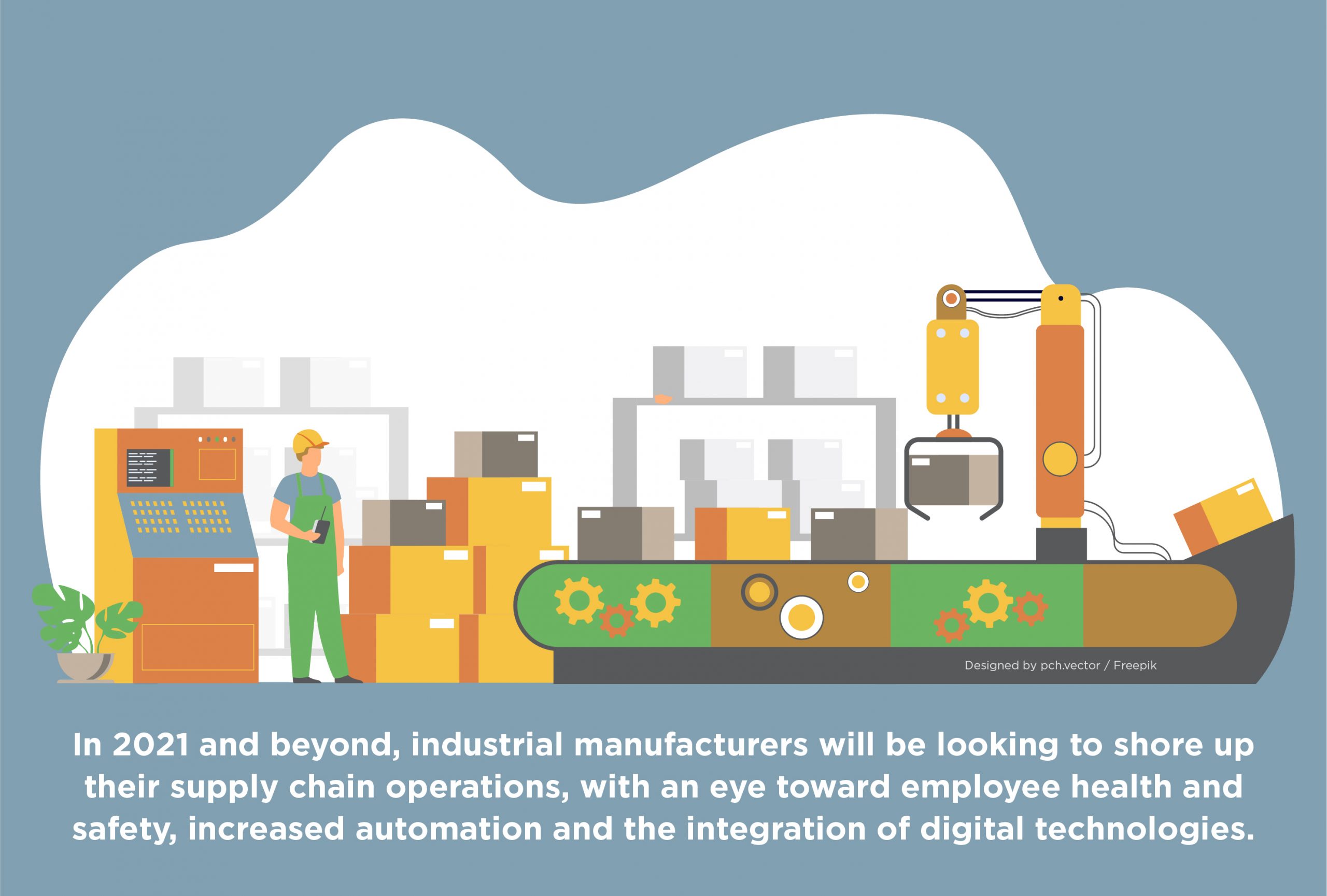The entire manufacturing sector has been materially affected by the COVID-19 pandemic, although the exact impact has varied significantly from one manufacturer to the next. For example, manufacturers of light vehicles and of raw materials such as steel saw steep drop-offs in production — as much as 99% in some instances — throughout 2020. Meanwhile, makers of paper products, specialty chemicals (like those in hand sanitizers) and consumer electronics all saw surging demand.
But even for manufacturers that weathered the storm and saw stable or increased revenues in 2020, there were formidable supply chain disruptions to navigate through along the way. In 2021 and beyond, industrial manufacturers will be looking to shore up their supply chain operations, with an eye toward employee health and safety, increased automation and the integration of digital technologies. Let’s examine some of the key trends to watch in the coming year.
1. Increased Investment in Digital Twins, AI and IoT
The use of digital twins in manufacturing is accelerating, due to a combination of the COVID-19 pandemic, the maturation of related technologies such as artificial intelligence (AI) and the expansion of the Internet of Things (IoT). Juniper Research has projected a 17% year-over-year increase in spending on digital twins technology in 2021, driven by manufacturers.
A digital twin is a representation of a physical object, with the ability to simulate any changes to that item based on the data stream from its connected sensors. In industrial manufacturing, one of the central digital twin use cases is predictive maintenance, as a digital twin can offer continuous, real-time insights into product wear and tear and make recommendations on any necessary fixes.
This approach, powered by numerous IoT devices and AI, can save manufacturers substantial sums. Instead of costly outages, repair and warranty liabilities, they can keep their operations consistently on track and more reliably respond to changes in customer demand.

2. Sharper Focus on Employee Health and Safety
Virtually all Fortune 1000 companies experienced supply chain disruptions as a result of COVID-19. Staff shortages among manufacturers, due to coronavirus infections, significantly contributed to these issues, underscoring the importance of prioritizing employee health and safety in 2021 and beyond.
Many of the essential tasks that these workers perform aren’t being automated, despite ongoing predictions that robots or other forms of automation could perform them. While investment in robots is rising — there were nearly 3 million of them in use in September 2020, a record, per the International Federation of Robotics — human workers are vital, and manufacturers will look to promote their well-being through a combination of COVID-specific and more general measures, including:
- Physical distancing.
- Protective gear and equipment.
- Real-time monitoring and communications.
- Regular trainings.
- Consistent inspections and reviews.
3. Localized and Near-Sourced Production
More manufacturers may begin or continue moving their production closer to consumption in 2021. This trend began even before COVID-19, in response to the rising costs of shipping from Asia, as well as concerns about geopolitical tensions and the environmental footprint of far-flung, carbon-intensive global supply chain operations.
But COVID-19 put into sharp relief the risks of complex, widely distributed supply chains, which can break down more easily than ones closer to the manufacturer’s home. In response, some organizations may look to reduce supply chain risk by relocating their operations.
Localized and near-sourced production may lower transportations costs, avoid regulatory complexity (e.g., changes in international trade agreements) and support certain types of branding, e.g. “Made in the U.S.A.” for some American firms.
4. The Ongoing Transition to Cloud
Cloud infrastructures and applications provide much more flexibility and scalability across supply chains than possible with legacy IT. For examples, one industrial manufacturer sought to harness the unique power of cloud-based supply planning, a project for which it enlisted the help of Inspirage.
Key processes such as sales order quoting and promising were moved from on-prem to cloud systems with all functionality intact, while many time-consuming manual processes were automated. The organization can now automatically pull in its sale orders based on selected criteria, greatly streamlining its ability to ensure consistent delivery to its customers.

Want to learn more? Make sure to download our Customer Spotlight and to connect directly with an Inspirage team member for your next project!